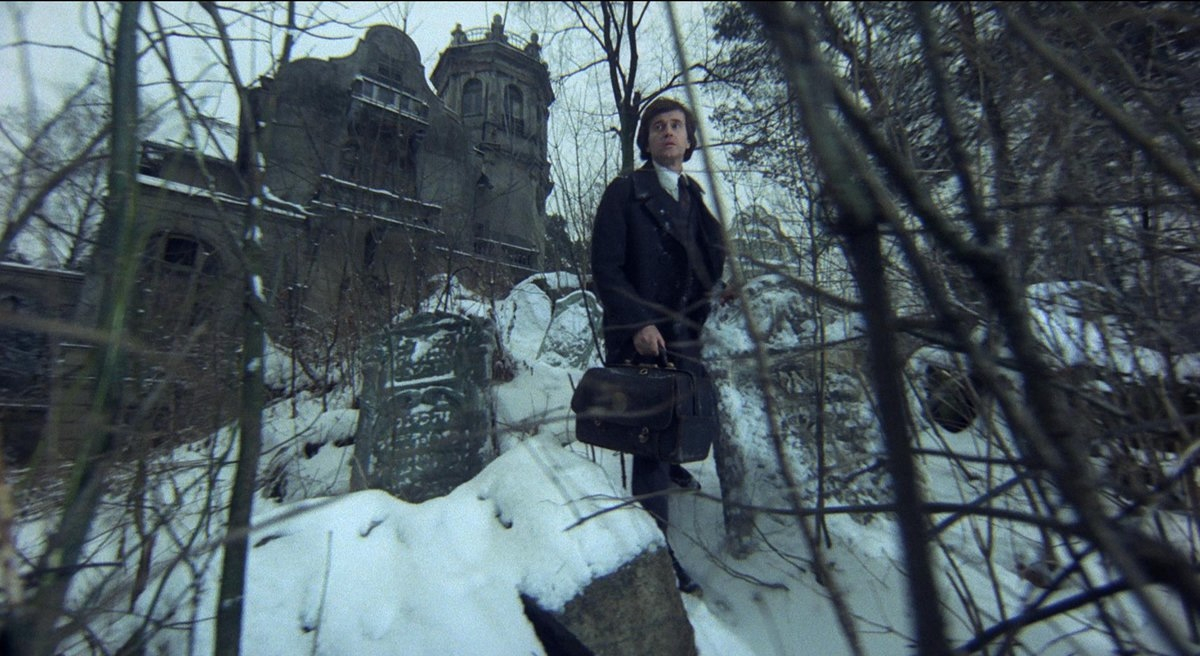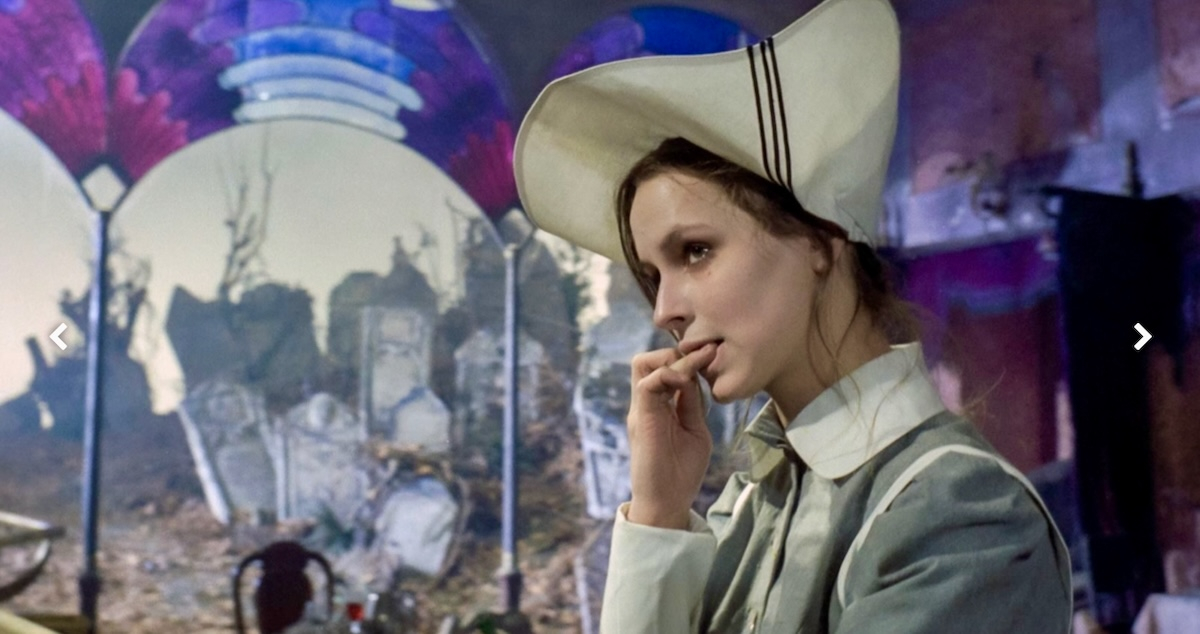
All that we see or seem
Is but a dream within a dream
—from Edgar Allan Poe's Dream Within a Dream (1850)
Old rope, maybe (Poe was a laudanum devotee)—or one of the oldest tropes in surrealist film and literature.
Episodic stories told through a framing device, stories that refer to and fold in on themselves in defiance of both logic and the space-time continuum—mythological dreams within dreams, in other words—can most likely be traced back in literature to the Epic of Gilgamesh (2150 B.C.E.).
To that, we might add Homer's The Iliad and The Odyssey (*00 B.C.E.), Chaucer's Canterbury Tales, Boccaccio's The Decameron, Petronius's Satyricon, the Arabian Nights, Gabriel Garcia Marquez's One Hundred Years of Solitude, and its sundry magic-realism spinoffs—and especially for our purposes here, two towering works by Polish authors: Count Jan Potocki's 1815 The Manuscript Found in Saragossa…and Polish-Jewish author Bruno Schulz's limited but profoundly impressive body of interlocking stories published in 1934 as Cinnamon Shops a/k/a Street of Crocodiles, and also his 1937 novel Sanatorium Under the Sign of the Hourglass.
In film, Luis Bunuel and Salvador Dali's radical dream opus, 1928's Un Chien Andalou, set the pace. Bunuel carried on this dream within a dream tradition in much of his work, culminating in his late '60s and early '70s cinematic trifecta comprising 1969's The Milky Way, 1972's The Discreet Charm of the Bourgeoisie, and 1974's The Phantom of Liberty.
Other films in the tradition include Carl Dreyer's 1932 wispy-through-a gauze, darkly ectoplasmic fever dream Vampyr, the multipartite U.K. ghost story anthology 1945's Dead of Night, John Parker's and Bruno VeSota's 1955 Dementia (a/k/a Daughter of Horror), any of the Hammer and Amicus horror anthologies beginning with Tales From the Crypt through Asylum, most of David Lynch's films (especially Mulholland Drive)—and of course, Federico Fellini's full-on retinal assault 1969's Fellini Satyricon, and for me, his most magical confection, 1976's Fellini Casanova.
Special mention should be made to Alain Resnais's 1961 Last Year at Marienbad, Louis Malle's zany, discontinuous 1960 Zazie Dans le Metro, Vera Chytilova's 1966 Daisies, and Patrick McGoohan's 1967 Kafka-goes-Mod television anthology The Prisoner, which set the bar high for sheer wtf-ness that contemporary shows like Lost can only hint at.
For me, though, the ne plus ultra of dream cinema was always master Polish filmmaker Wojciech Has's 1965 The Saragossa Manuscript, a black and white adaptation of the aforementioned Count Potocki's literary magnum opus, a hodgepodge of cabalistic magic, military derring-do, esoteric lore, European folk tales, and occult conspiracies. Rich in madcap visual invention, with startling time-shifts and numerous stories within stories within stories, it is no accident that this was one of Jerry Garcia's favorite films, along with directors Luis Bunuel, Francis Ford Coppola, Martin Scorsese, and Lars Von Trier.
I say "was always"…that is until I finally bore witness to what I can only describe as Has's 1973 magnum opus, The Hourglass Sanatorium, a/k/a Sandglass, which doubles down on the dream logic throughout in a two-and-a-half hour cinematic phantasmagoria containing multitudes within.
Ostensibly a film about Josef, a 19th-century traveler played by well-known Polish actor Jan Nowicki, who takes a long train journey through the Polish night to a creepy, dilapidated sanatorium surrounded by a graveyard in order to visit his dying father, the film erupts after Josef is put to sleep by a sinister Doctor and his nubile nurse into a riot of dream fugues which so scramble the space-time dialectic that the audience at Lincoln Center's Walter Reade Theater the other night was cowed into silence—not a word was spoken during its unspooling, not a single soul got up to use the facilities—all focus was on this film.
In fact, the only response during the entire 2 1/2 hours was one collective audience guffaw at a deliberate play on the words "new Mexico" in contrast to "old Mexico" by a child philatelist playing a younger version of Josef interacting with his grown-up self.
Reminiscent in parts of an American International vintage '60s Poe film (Daniel Haller-like sets, Floyd Crosby-esque ultra-fluid cinematography), Peter Brook's infernal 1967 Marat/Sade, a late Fellini film gone mad, and any number of Marc Chagall paintings, with a heavy "Golden Age of Czech animation" influence (the fantastic assemblages of Jan Sjvankmajer and Karel Zeman come to mind), Has's film is a relentless mind-blowing assault on the senses. It deserves to be seen—in fact, begs to be seen again—multiple times if only to even partially unlock his rich and strange mise-en-scene and scenario.
Setting the stories of Bruno Schulz to the big screen should have been an impossible task. Schulz's writing is so singular and imaginative one basks in his overall way with words; his multi-dimensional surrealist imagery glows on the page in glittering jewels of thought. His prose style is so luxurious and fabulistic, like the Kabbalah itself, that it should be proscribed reading, not engaged with by rabbinical diktat until the reader hits the ripe old age of 40 (just kidding). This is to say that there has never been a writer quite like Bruno Schulz.

But Has was more than up to the task of translating Schulz to the wide-screen canvas. Here, he cherry-picked some of the best tales from Cinnamon Shops and Hourglass and added his emphasis on overtly Jewish themes that are absent (or, more appositely, well-hidden) in Schulz's original tales. Has also introduced a pronounced erotic component only hinted at in the original stories, which he would undoubtedly be chastised for today—if not canceled outright.
This fate nearly befell this film in general, which the Polish government tried to suppress, partially because of the overtly Jewish content throughout but also because of the film's depiction of the run-down sanatorium and surrounding grounds, which might be taken as a commentary on Poland's at the time semi-ruined infrastructure. Had it not been for a single print smuggled out of the country and shipped to the Cannes Film Festival, where it won the Jury Prize in 1973, this film might never have been exhibited anywhere.
This extra-Jewish quality apparently was Has's reaction to Bruno Schulz's Jewish identity (although Schulz spent most of his life in a small town in Poland on the Ukrainian border as a non-observant Jew who also loved Catholic rituals. He was murdered by a Nazi officer for wandering out of the Dohobrych Ghetto into the "Aryan Area" in 1942)—and also his reaction to the ensuing Polish clampdown on Jews and Jewish culture in 1968, itself a kind of reactionary fallout from the Prague Spring flourishing next door in Czechoslovakia. This world-historical episode terrified Poland's then-Russian overlords, who blamed the revolutionary fervor on the International Jewish Conspiracy from Hell and accordingly clamped down on the Polish Jewish community, many members of which emigrated en masse to Israel, Europe, and the U.S.
From the opening sequence on the train, with its eerie foreshadowing of the trains to Polish-based concentration camps, to a heart-stopping scene near the end in which a tumultuous herd of panic-stricken Jews hurtle past the camera in a mad dash, dragging their meager possessions behind them while trying to escape an off-screen angry mob with a deadly pogrom on their agenda, Has repeatedly ramps up the Jewish quotient in the service of near Proustian poetic themes: the inevitable passing of time, glimpses of a lost era in Polish Jewish history, fragmented memories of happier days, and endless nights.
Some of the panoramic scenes here displaying crowds of dancing Chasidim in colorful but dark, very dark shtetl settings (reminiscent of contemporary Krakow's Kazimierz district, a kind of Potemkin Village recreation of old Jewish Poland) resemble nothing so much as a Bizarro World version of Norman Jewison's 1971 Fiddler on the Roof mega-hit, with traces of Abraham Polonsky's 1971 Romance of a Horsethief. Mention should be made of the influence of Michal Wasynski's spectral 1937 supernatural fairytale The Dybbuk, particularly the weird Wedding Dance sequence, which Has, one of the icons of the 1960s New Polish Cinema alongside such directorial giants as Jerzy Skolimowski, Roman Polanski, and Andrej Wajda would have known very well—an essential work in the history of Polish filmmaking.
Special thanks to Prof. Annette Insdorf's exceptionally informative pre-screening talk, which contextualized the film. Her excellent book Intimations: The Cinema of Wojciech Has contains valuable information on Has's impressive career.
There is so much more to unpack about this particular film. I really cannot wait to see it again: https://vinegarsyndrome.com/products/the-hourglass-sanatorium
